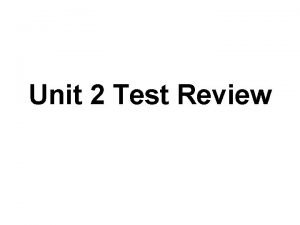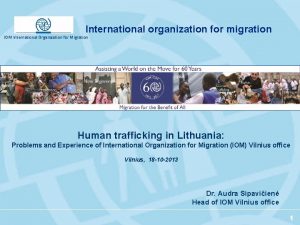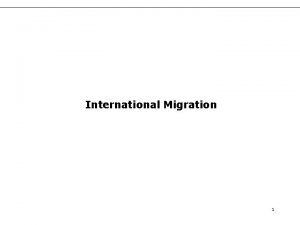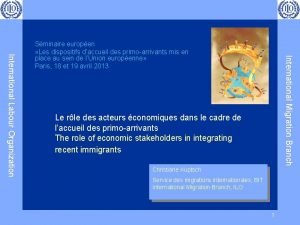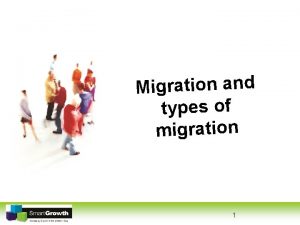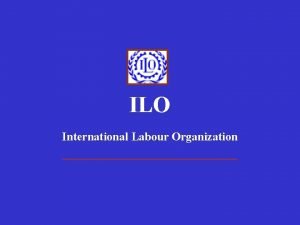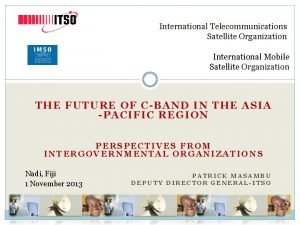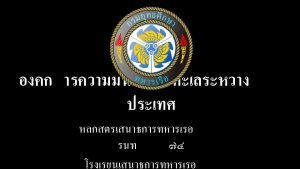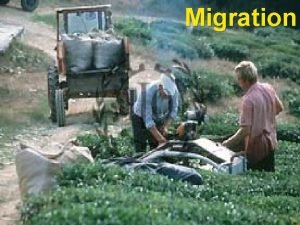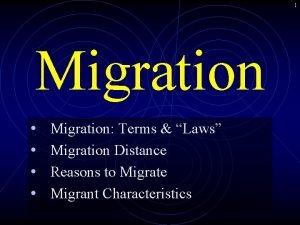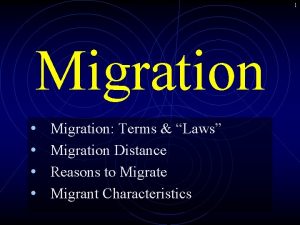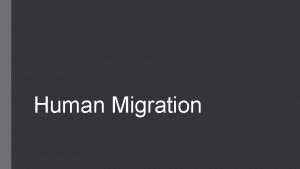International Organization for Migration The current migration and
















- Slides: 16

International Organization for Migration The current migration and refugee flows and smuggling of migrants EIAS Briefing Seminar 10 May 2016, Brussels

Outline • Global and EU migration trends and flows • Types of irregular migration and its drivers • Smuggling of Migrants - difference with human trafficking • Current trends of smuggling of migrants • Proposed responses 2

Global and EU Migration. Trends • Syria is the largest refugee-producing country, with a refugee population of 4. 2 million by mid-2015. • Turkey and Pakistan are the main refugee-hosting countries globally with 1. 84 and 1. 51 million refugees registered by June 2015; they are followed by Lebanon (1. 2 million) and Iran (982, 000) • The EU-28 as a whole received over 1. 2 million new asylum claims in 2015, more than double the number of asylum claims in 2014 (most of these claims were made in Germany, Hungary , Sweden, Austria, Italy and France) • Children represented nearly 33% of first-time asylum applicants in the EU-28 in 2015 • At least 5, 417 migrants died or went missing during migration in 2015

Migration Flows 2015 -2016 2015 – drastic increase of arrivals to Europe • 34, 887 total arrivals to Europe by land • 1, 011, 712 total arrivals to Europe by sea • Countries of first arrival: Greece, Italy, Spain, Bulgaria, Malta, Cyprus • Other countries: FYROM, Serbia, Hungary, Croatia, Slovenia

Migration Flows 2015 -2016 • Total number of arrivals in first quarter of the year - 174, 395 • 56, 814 migrants and refugees were stranded in Greece, FYROM, Serbia, Hungary, Croatia, Bulgaria and Slovenia as of 31 March 2016

What is irregular migration? Denotes movement that takes place outside the regulatory norms of the sending, transit and receiving countries From the perspective of the sending country it is, for example, crossing an international border without a valid travel document From the perspective of the destination country it is entry, stay or work in the country without the necessary authorization or documents required under immigration regulations

Drivers of irregular migration ‘Push’ factors: §Conflict, instability (recent, protracted) §Poor governance and endemic poverty §Impact of climate change ‘Pull’ factors: §Vision of a secure, better life ! Mobility is magnified by unprecedented levels of connectivity 7

Smuggling of Migrants Migrant smuggling is “…the procurement, in order to obtain, directly or indirectly, a financial or other material benefit, of the illegal entry of a person into a State Party of which the person is not a national or a permanent resident” (Art 3 Smuggling of Migrants Protocol) • It is a highly profitable business – relatively low risk of detection and punishment and thus increasingly attractive to criminals • Modus operandi vary from highly sophisticated (document and visa fraud) to low-cost methods which pose high risk for migrants • Migrant smugglers constantly change routes and modus operandi in response to changed circumstances • Smuggled migrants are vulnerable to life-threatening risks, abuses, exploitation

Smuggling of Migrants: Recent Trends • Growth of ‘marketing’ of smuggling via Facebook : ‘The biggest illegal travel company in the world’: Information about prices, departure points, logistics for the travel, updates on weather and boat departures, advantages and disadvantages of various asylum systems • Development of ‘packages’ – especially for Syrians (e. g. include a life jacket, space on the deck, ‘all-inclusive’ journey to Europe) • Pricing: 2, 000 EUR person to cross from Libya to Italy (more if the entire trip is ‘purchased’ from the country of origin to destination), 4, 000 – 6, 000 EUR from Turkey to Europe (depending on the route)

Differences between Human Trafficking & Smuggling of Migrants

Differences between Human Trafficking & Smuggling of Migrants • Smuggling of people across international borders is typically viewed from a law enforcement lens, with less systematic examination of the human rights implications of smuggling. • However, migrant smuggling – as trafficking in human beings is routinely associated with human rights violations • In the present context of “desperate migration” in the Mediterranean region, migrants who resort to are extremely vulnerable and easy targets for exploitation • Migration paths which begin with smuggling may very well end up as trafficking in human beings: Debt-bondage of the smuggled person towards his/her smuggler very often leads to subsequent exploitation by the smuggler

Current Migration Crisis in Europe: Trafficking Cases Past 10 years: Smuggling connected to Trafficking of migrants arriving in Italy – well known Recent Crisis: Egyptian unaccompanied children in Greece: DEBT BONDAGE Nigeria girls in Italy: SEXUAL SLAVERY (80% of arrivals) Others? Smugglers allow migrants to pay their services once at destination

Smuggling of Migrants Response Ø Mitigate ‘push’ factors Ø Promote stability, create education and employment opportunities Ø Information campaigns on the risks of migrant smuggling Ø Help migrants in distress and save lives (search and rescue operations, humane and dignified reception) Ø Create alternative means for migration: labor migration, resettlement, humanitarian admission Ø Prosecute migrant smuggling Ø Enhance international, regional and inter-regional cooperation of law enforcement agencies (see ‘Bali Process’)

Comprehensive policies • Opening more regular channels for migration • Amnesty / regularization for irregular workers • Assisted voluntary return and reintegration (as part of functioning migration management and asylum systems) • Regional mobility schemes • Regional cooperation and cooperation with countries of transit and origin

Concluding Remarks Restrictive policies increase the demand for migrant smuggling services, drive up the fees and push smugglers to change their routes The migrant smuggling business is unlikely to be stopped by restrictive policies without alternative legal avenues for migration With Trafficking in Human beings we have already observed that restrictive policies have led traffickers to change their modus operandi and use regular migration channels The trafficking in human beings business is unlikely to decrease unless further actions are taken to mitigate the root causes / vulnerability of at-risk populations as well as demand reduction

Thank you for your attention! 16
 Line current and phase current
Line current and phase current Line vs phase voltage
Line vs phase voltage Drift current and diffusion current
Drift current and diffusion current Line current and phase current
Line current and phase current Drift current and diffusion current
Drift current and diffusion current What is diffusion current and drift current
What is diffusion current and drift current Balanced wye-wye connection
Balanced wye-wye connection Slideplayer
Slideplayer Diffusion current formula
Diffusion current formula Geophenom
Geophenom The constant current region of a jfet lies between
The constant current region of a jfet lies between Chapter 3 shielded metal arc equipment setup and operation
Chapter 3 shielded metal arc equipment setup and operation Touch current vs leakage current
Touch current vs leakage current Kcl mesh analysis
Kcl mesh analysis Block arrangement essay
Block arrangement essay Interregional migration ap human geography
Interregional migration ap human geography Firms that emphasize global integration make and sell
Firms that emphasize global integration make and sell









